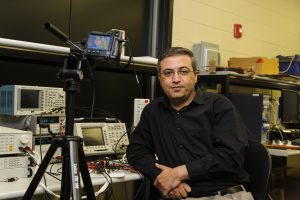
TUSCALOOSA, Ala. — Electronic devices could be made cheaper, smaller and more efficient by reducing the complexity of their internal method of converting and regulating energy, according to a patent by a University of Alabama engineering professor.
An indispensable part of electronic devices, a power converter transforms incoming electricity to a form useable by the device. Increased sophistication of electronics, especially mobile technology, has required more complexity in power converters, driving up costs and energy used by the electronics.
However, Dr. Jaber Abu Qahouq, associate professor of electrical and computer engineering in the UA College of Engineering, developed a controller for power converters that does not need to sense the current traveling through the device in order to improve the way power is supplied to the device. This could eliminate existing methods used for the same function, reducing complexity, size, cost and energy.
“The current and future trends require smaller size of these power converters with lower power consumption or power losses,” said Abu Qahouq. “Mobile devices and computing platforms, particularly, require accurate low voltages, high currents and/or stringent, dynamic performance in very small footprints.”
The patent covers what Abu Qahouq calls a sensorless adaptive voltage positioning controller, or SLAVP, to be used in DC-DC power converters, or those that transform one level of direct-current, DC, electricity into the level of DC electricity needed for a device to function properly.
A power converter receives an input voltage from an energy source, such as a battery or another power adapter, and it produces a desired output voltage to a load, such as an electrical device, electronic circuits or a computer chip.
For instance, a computer chip receives power from a power converter, which supplies the electrical current needed for the chip to function. The required electric current by the computer chip is higher, for example, when running a graphic-heavy program, but it is lower when running a simple word-processing program or when in sleep mode.
In fact, the amount of power needed can fluctuate wildly within fractions of a second during the computer’s use. The power converter’s job is to make sure the output voltage is within a tiny, acceptable range that powers the load needed at the time, avoiding destruction or operation malfunctioning to the load, which, in this example, is a computer chip.
Part of the power converter technology is the controller, which is programmed equations and logic that sense electrical voltages, currents or both, as well as control transistors or switches to deliver the appropriate form of power to the load. An adaptive voltage positioning, or AVP, controller is able to move the electric voltage level based on the electrical current level that helps the electronic device work better and more efficiently with a smaller size. But, it is an expensive piece to add to a converter and adds size and losses.
Abu Qahouq’s technology, the SLAVP, would eliminate the need for the controller to sense the current, using other parts readily available in power converters to perform the same function, reducing size, cost, power loss and complexity.
“While conventional AVP control schemes have been mainly used in high-end applications where additional cost might be justified, the new patented SLAVP control makes it possible to integrate such important and beneficial control in a variety of DC-DC power converters used in wide range of applications,” Abu Qahouq said.
The SLAVP controller could help make power converters efficient in a different way, as well. There is a trend to make these DC-DC power converters more intelligent, reconfigurable and able to communicate with the loads they power. To do that efficiently in today’s devices, the controller uses digital equations and algorithms. This means that when a signal, such as the current, is sensed an expensive and relatively large analog-to-digital converter is needed to convert the analog current or voltage to a digital format for the digital controller to use.
With the ever shrinking size of computing power, these analog-to-digital controllers can still use a lot of space and power, influencing a device’s size.
Abu Qahouq’s patented method, the SLAVP controller, eliminates the need for such analog-to-digital conversion for AVP current sensing because it does not need high-speed, high-accuracy current sensing. The results are power converters that could achieve high dynamic performance with accurate voltage regulation needed for the load at reduced cost, size and power loss.
The U.S. patent granted to UA and Abu Qahouq claims a controller architecture, mathematical control law and an algorithm that when used or programmed to control the DC-DC power converters, should achieve advantages over conventional controllers.
The UA Office for Technology Transfer is working with Abu Qahouq to market the patent and related technology for commercial use.
U.S. Patent Designated No. 8,674,674 was granted March 18.
Contact
Adam Jones, engineering public relations, 205/348-6444, acjones12@eng.ua.edu
Source
Dr. Jaber Abu Qahouq, 205/348-8669, jaberq@eng.ua.edu